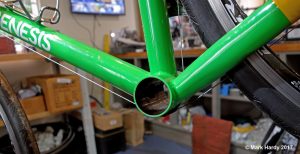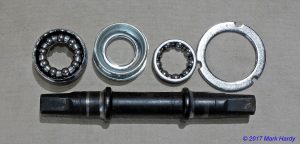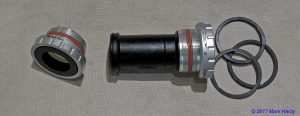The bottom bracket is an essential component of the drive train. The efficient transmission of energy from the leg muscles, to pedal, to crank, and then to the chain via the chainset is facilitated by the bottom bracket. For the energy from the rider to translate to the most efficient forward motion of the cycle, and not be lost energy via dissipation, requires a bottom bracket that is tight in the frame and freely spinning. The bottom bracket is a bearing. As a bearing, its efficiency comes from its low friction spinning and low lateral movement in the form of rocking. The less the bottom bracket moves from side to side, and the less friction the spinning bearing has, the better the bottom bracket is at doing its intended job. The bottom bracket sits inside a short tube through the frame bottom, termed the bottom bracket shell. The shell sits at the base of the cycle frame and is the meeting point of the down tube, the seat tube and the chain stays. The bottom bracket shell appears then to occupy an important structural position. It feels the weight of the rider and encloses the bottom bracket, which itself is experiencing the forces transmitted to it from the pedalling rider via the crank arms. The width of the bottom bracket shell is usually allied to the responsive performance requirement of the cycle type. Wider shells add stiffness. Cyclists that require maximum response from effort put into pedalling are given this advantage by a wider stiffer shell.

The bearing function of the bottom bracket must operate amidst the down force of the rider through the seat tube and the side-to-side rocking from pedalling.
With most cycles bottom bracket shells are threaded at both entrances, commonly a left hand thread on the right side of the bracket (from the point of view of a sitting rider), and a right hand thread on the left side. This is at first sight counter-intuitive as it may be expected that pedalling motion of the crank may result in slowly unthreading the bottom bracket from its shell. In fact the reverse is true. It is common knowledge that with pedals, that they have a right hand thread on the right pedal and crank arm, and a left hand thread on the left pedal and crank arm. This is because clockwise pedalling (as seen from the right side of the cycle) helps to keep the pedal tightened into the crank arm. Viewed from the left side of the cycle, pedalling is anti-clockwise and hence a left hand thread is required so pedalling does not unscrew the pedal from the crank arm. With threaded bottom brackets the rotational forces on the thread are not the same as those between pedal and crank. The moving sections of the bottom bracket; the bearings in their bearing surfaces, produce an opposite rotation effect termed precession. Clockwise motion of the bearings produces an anti-clockwise rotational movement of the bottom bracket in its position in the threaded shell. The opposite rotational movement is true for the left side of the bottom bracket shell.
The quality differences between bottom bracket bearings are found in the areas of how highly polished the ball bearings are, their sphericity, the quality of the materials of the ball bearings and the cage they race in, the quality and robustness of the seals (keeping moisture and dirt out), and the quality of the lubricant. There is also a weight consideration for road bike riders that wish to have as lightweight components as possible. Ceramic bearings used in wheels and bottom brackets are marketed robustly to road bikers who obsess about minor improvements, but various studies reveal little real gain over high quality stainless steel bearings when tested on a level playing field. The optimum function of good bottom bracket bearings is realised when a number of factors such as quality of ball bearings (not necessarily material), seals, lubricant and correct fitting are met. This is certainly relevant for 99% of cyclists.
On modern factory-produced cycles there are five common types of bottom brackets. Press fit, external, sealed, semi-sealed and self assembly.
As with all components on factory built cycles, generally, the type and quality of bottom bracket is associated with type and quality level of cycle. With economy children’s cycles, the self assembly bottom bracket is common.

This is usually a series of ring fittings with two bearing racers. This assembly fits around a central axle that fits through the bottom bracket shell. These bottom bracket assemblies are not sealed from the elements and can let in moisture and dirt.
Semi-sealed bearings can be found on some children’s cycles and on entry level adult cycles. The benefit here is that only one side of the bottom bracket requires the bearings to be “set up” (adjusted by the bike shop dealer during assembly out of the box). The semi-sealed side is set up correctly at the factory and as sealed, that side of the bearing is more resistant to the ingress of moisture and grime.

Sealed bearings are sealed at both ends, are more resistant to the ingress of moisture and grime on both sides and these bearings are found on cycles that generally occupy a rung or two higher up the quality ladder.
On many cycles such as the highest quality hybrid bikes and road bikes built to a good standard, external bearings are common. These bottom brackets are still screwed into the shell, but their bearings are not internally positioned within the shell, but sit just outside. This system permits the manufacturer to offer advantages to cycles that are designed to be more responsive to energy input from the rider. External bearings are larger and each bearing set is further apart from each other than seen in common sealed bearings. This adds rigidity to the bottom bracket. This system also permits a slimmer axle so external bearings can be made to be lighter in weight, exactly what road bikers (for example) are looking for.

The major manufacturers have their own designs of external bearing bottom brackets, the most common seen on factory-built cycles being Shimano’s Hollowtech II. FSA brand external bearings are also found on some road bikes and mountain bikes. Other brands of external bearing bottom brackets include Race Face and SRAM.
The final bottom bracket type is the press fit bearing bottom bracket. These are bearings that are not screwed into place but pressed (forced) into position within the bottom bracket shell in an interference fit. With some press fit bottom brackets the bearings are pressed directly into the shell, whilst some others have the bearings in an extra nylon housing which is pressed into the shell. There are benefits to press fit bearings that happily fit perfectly with the requirements of enthusiastic amateur and professional cyclists. Press fit bearings are lighter in weight than external, sealed and semi-sealed bearings. With lightweight road bikes in particular this helps (along with other lightweight components), in keeping the bike as light as possible.

The axle in press fit bearing bottom brackets is designed to be permanently attached to the drive side crank arm as part of that crank arm. The opposite crank arm is then fitted when the cycle is assembled. Another advantage of the press fit bearing is that as they are pressed into the shell, they do not sit proud of the shell and are hence the bearing of choice to suit the wider stiffer shell. In some cases this means that a particular axle length can be used on both external bearing and press fit bearing bottom brackets. The types of press fit bearings are denoted by BB (the exception being SRAM PF). Various manufacturers give their developed press fit bottom brackets a particular number such as BB30 or BB86 and usually they are incompatible with each other in terms of using one bottom bracket with a crankset designed for another. This is usual with higher quality road bikes and mountain bikes, and fits with the culture of manufacturers desire to see their brand dominating drive train mechanics on high quality branded bikes.